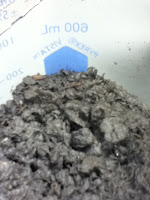Specific Heat Lab
Purpose: The
purpose of this lab is to use what we know about energy and heat to
determine an unknown block of metal given to us. The metal will either
be aluminum, brass, copper, lead, stainless steel, or zinc. To determine
which metal it is, I will place it in water, heat up the water, take
the temperature of the water, and then place the metal in room
temperature water and find the temperature difference. I will also use
the weight of the metal to use it in an equation to find the temperature
lost in the metal.
Background: As
part of my some of background knowledge, I looked back to a food lab
that I had done previously where we worked with calories. 1 calorie is
the amount of heat needed to raise 1 gram of water. 1 °C of water is
equal to 4.186 joules/gram. To find the heat of the metal and identify
it, we will use the following equations:
Qw = heat water gained
Mw = mass of water
Cw = specific heat of water
△Tw = water after metal-before
Qm=MmCm△Tm
Qw = heat water gained
Mm = mass of metal
Cm = specific heat of metal
△Tm = hot metal-cold metal
Specific Heats J
g(k)
Water = 4.184
Aluminum = 0.897
Brass = 0.385
Copper = 0.385
Lead = 0.385
Stainless Steel = 0.490
Zinc = 0.390
When
the water reaches its boiling point with the metal in it, they will
reach an equilibrium where the temperatures of both the water and metal
will be the same. This is because the heat from the metal transfers to
the water.
Materials:
- Two beakers
- Metal Sample
- Water
- Hot Plate
- Metal Tongs
- Thermometer
Procedure:
1.
Weigh cup and then weigh it with 150 ml water inside. This will be the
room temperature water. Take the temperature of it and record
2. Weigh beaker and then weigh it with 150 ml of water in it. Record
3. Weigh metal. Record
4. Place metal in the water in the beaker, turn on hot plate, and place beaker on the hot plate
5.
Wait until the water starts boiling. This indicates that they have
reached an equilibrium. To make sure it is equal, wait 1 minute to take
the temperature of the water.
6.
Once the temperature has been taken, using the tongs, take the metal
out of the beaker and place it in the room temperature water
7. Place the thermometer inside the cup until the temperature has stopped fluctuating. Record data
8. Clean up
Temp of room temperature water: 20.9 °C
Temp of hot water: 100 °C
Temp of hot metal: 100 °C
Temp of cold metal: 24.1 °C
Temp change of water: 3.2 °C
Temp change of metal: 75.9 °C
Weight of styrofoam cup: 2.026 g
Weight of cup w/150 ml water: 147.291 g
Weight of metal: 68.015 g
Calculations:
Qw=MwCw(△T)w
(Mass of water)(Specific heat of water)(Room Temp water after-before)
Qw=2008.32 degrees Celcius
Qm=MmCm(△T)m
(Mass of metal)(Cm)(Hot metal-cold metal)
2008.32 °C =(68.015)(Cm)(75.9)
2008.32 °C =(5162.34)(Cm)
2008.32 °C =(Cm)
5162.34
0.3890 = Cm
Conclusion:
The
purpose of this experiment was to identify an unknown block of metal
given to us using what we know about energy and heat. From my results, I
concluded that my metal is zinc because the heat of zinc is 0.390
joules and my metal was 0.389 joules. I unfortunately did not have
enough time to do any other trials for this lab to make sure my results
were more accurate. Thankfully there was no major mistakes made in this
lab except I probably could have been more accurate in my measurements
such as when weighing things. I think I succeeded at fulfilling the
purpose of this lab by how I was able to identify the metal. 




















